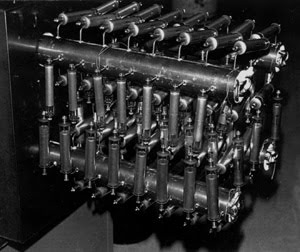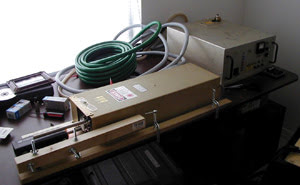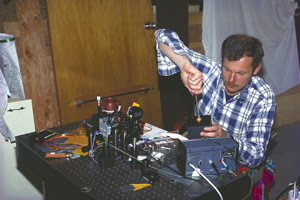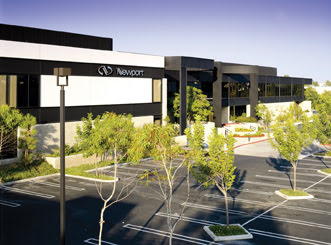Dr. Milton M.T. Chang, !%Incubic Management LLC%!
History is useful only if we can draw useful generalizations from it. And there was a lot
to learn from building companies in our industry, especially in the early days.
My laser career began in 1963, in my senior year at the University
of Illinois, when, while working as a part-time student lab technician, I took on
the assignment to build a ruby laser to study laser cavity modes. After receiving
my graduate degrees, I began my entrepreneurial career in 1971, joining Newport
Corp. as its seventh employee. And I was an active angel investor when I was running
Newport and New Focus Inc.
Starting a company way back when
In the early days of the laser industry, before the word “photonics”
was made popular by Laurin Publishing Chairman and CEO Teddi C. Laurin, a technical
person like me could successfully start a company without any business experience
simply by using common sense and capitalizing on his or her expertise. All you
had to do was identify a need in your area of specialization and work hard at it.
You didn’t even have to worry much about established companies breathing down
your neck because there were only a handful of them, and they had plenty of opportunities
without bothering to lock horns with you on your niche technical turf. And there
were plenty of investors wanting to jump on the glamorous laser bandwagon who were
willing to provide capital.

HeNe lasers from Uniphase became the gold standard, thanks to the
company’s focus on continuous improvements to manufacturing processes. Courtesy
of Dale Crane, founder of Uniphase (JDSU).
Against that backdrop, opportunities were abundant. I was fortunate
to have caught the wave for a very long ride: I was involved in founding, running
or serving on the boards of several companies – Newport, Uniphase and Cyonics
(later JDSU), Iridex, Lightwave Electronics, CyberOptics, NEOS, Laser Power Optics,
Questek, Cleveland Crystals and Rochester Photonics – before I started New
Focus.
Uniphase
Once upon a time, HeNe lasers made by Optics Technology Inc. were
the ones to buy. They had a “compact” functional design, with the laser
mounted on top of the power supply. The lasers looked nice, but output power would
drift as the power supply heated up the laser tube. The company soon came to an
end when Spectra-Physics introduced its beautifully engineered line of HeNe lasers
supported by its professional sales force.
Then, in 1979, came Uniphase, with Dale Crane at the helm, sweating
every detail in manufacturing. It was the only company that could respond to Symbol
Technology’s demand for a rugged, reliable and low-cost laser to make handheld
laser scanners.
Uniphase invested in a new manufacturing facility to increase
capacity, and it improved quality and lowered costs by making continuous improvements
in its manufacturing processes. With Dale on top of every aspect of the business,
the company reduced the rate of reject and rework from the industry norm of something
like 8 percent to less than 1 percent.

Shown is a Uniphase HeNe laser, the Lexel 88 argon-ion, and its power supply. Courtesy of photographer Gregory
Maxwell.
Spectra-Physics eventually abdicated to buying lasers for its
scanner division from Uniphase – and the rest is history. The lesson learned
is that the technology is important but that novelty wears off, and every product
competes on quality, performance and price.
Iridex
This company, originally Iris Medical, set out in 1989 to build
ophthalmic therapeutic systems that use semiconductor lasers to replace the cumbersome
argon laser systems. The founders, Theodore A. Boutacoff, David M. Buzawa and Eduardo
Arias, had little doubt that their product would replace existing systems because
theirs would fit so well into doctors’ offices – especially if the selling
price were comparable to the replacement cost of argon laser tubes.

David M. Buzawa, vice president of engineering at Iris (now Iridex), puts together a prototype
in the garage of Theodore A. “Ted” Boutacoff, the company’s president.
Courtesy of Iridex.
But semiconductor lasers were difficult to produce at the time
– and therefore very expensive – and users were placed on allocation.
The company knew that all that would change based on the pricing history of DVD
lasers and decided to forward-price the system; i.e., they priced the system based
on the cost of the laser projected out a few years. That affected early profits
but enabled the company to prevail in the long run. The lesson learned is that technology
is a necessary but insufficient condition to succeed in business. You also need
a sound business strategy.
Newport
This company started in 1969 with about a $150,000 investment
from the uncle of John Matthews, my California Institute of Technology schoolmate
who co-founded it with Dennis Terry. We bootstrapped our way to an initial public
offering without additional capital infusion.
We worked hard. John was president, responsible for engineering,
Dennis was responsible for manufacturing, and I was responsible for marketing and
sales. Our average workweek was more than 14 hours a day, six days a week –
sometimes more. John and I would brainstorm about every aspect of the business and
technology long after midnight, not paying attention to how time flew when we were
having fun.
We took care of our customers. Everyone at Newport (and, later,
at New Focus) knew that the phone had to be picked up within three rings and that
customers were not to be kept waiting more than 24 hours to get an answer. Over
time, our attitude of service helped, and I made many friends over the years, some
of whom have stayed in touch to this day.

At Newport, Milton Chang learned that just having a technical edge
is never enough for success. A company must focus on customer service, engineering,
manufacturing and more.
We strove to stay ahead of the competition. John had majored in
physics but had a knack for engineering. He designed all the mechanical hardware,
including manufacturing toolings, but his pride and joy was the innovation he made
in the tabletop damping system, which really made a big difference in optics research.
John’s uncle, a conservative Chicago banker, taught us how
to be fiscally responsible, and all three of us were by our very natures careful
spenders. We grew the company rationally, using only cash actually generated by
the business, and we increased profitability by investing in manufacturing processes
to reduce cost.
For example, we invested in an expensive stamping tooling to make
the vibration isolators out of steel plates instead of aluminum castings, which
gave us a better product at lower cost. And we designed and built a multispindle
head to drill and tap tabletop mounting holes on 1-in. centers to reduce manual
labor a hundredfold.
The lesson learned was that a technical edge alone is never a
sufficient condition for success. Your team must be able to execute a plan with
the right attitude toward customers, and with engineering and manufacturing expertise,
adequate capital, business and management acumen, marketing finesse – and
the list goes on.
Starting a photonics business today
Opportunities in photonics are still in abundance. But given that
the laser industry is now 50 years mature, you have to look harder, maybe even using
your special photonics expertise to get into an emerging field and find startup
opportunities. And when it comes to having to compete with established companies
in a mature industry, follow the adage “If you can’t beat ’em,
join ’em” by working toward an early acquisition instead of trying
to take your company all the way to revenue.
Looking back
What I miss the most is the pleasure of seeing investors and management
working collaboratively as a team. It is a big loss for everyone when the starting
point is on opposite sides of the table, as it often is today. You can still find
investors who are statesmen. Their hearts are in the right place, and they want
to build great companies.
The starting point is you, the entrepreneur, with the intention
of serving each customer well. You must see wealth generation as a derivative of
having built a great company. I hope you will respond to my call to rejuvenate the
entrepreneurial spirit of the good ol’ days.
Meet the author
Dr. Milton M.T. Chang, who is semi-retired, spends time mentoring
entrepreneurs. He has been an investor in the photonics industry and was CEO and
president of Newport Corp. and New Focus Inc. prior to forming Incubic Management.
He is a fellow of the IEEE, LIA and OSA and was past president of LIA and LEOS;
e-mail: [email protected]